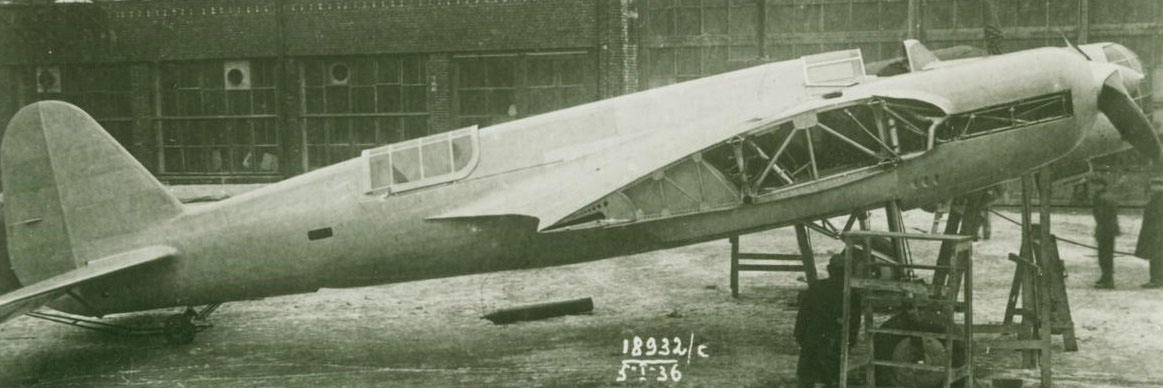
Aviation of World War II


 |
Aviation of World War II |


|
|
Soviet Union | Lend - Lease | Facts | Forum | Germany | Japan | R A F | U S A A F | Other | Photos | |||||||||||||||||||||||||||||||||||||||||||||||||||||
|
| |||||||||||||||||||||||||||||||||||||||||||||||||||||
ANT-41 (T-1)Torpedo BomberMyasishchev
During the aerodynamic design of the ANT-41, the experience gained during the creation of the SB was maximally taken into account and used. ANT-41 had a cantilever midplane scheme. Wing, fuselage and empennage skin is smooth, retractable landing gear. Crew - 4 people. In the nose of the fuselage there was a navigator (he was also a shooter of a mobile rifle bow installation - a rotating tower for a ShKAS machine gun). Next came the cockpit. In another cockpit, located behind the center section, there was a radio operator serving the lower gun mount (ventral tower for the ShKAS machine gun), and the gunner of the upper shooting point (a turret for a ShKAS machine gun, and in the future - for a ShVAK cannon for a cruiser variant). The radio operator's functions were transferred to the navigator. Structurally, the most difficult task was the need to place torpedo weapons inside the aircraft. The feasibility of such a layout solution was determined by the fact that the external suspension would greatly spoil the aerodynamics of the machine and would not allow it to achieve acceptable flight performance. 
At different stages of the ANT-41 design, the options for its torpedo armament changed. If at first it was assumed that the aircraft should carry two torpedoes weighing 820 kg each or one with a mass of 1700 kg, then they settled on one TANF torpedo weighing 920 kg. But even it required a bomb bay of an unusually large length - 6.5 m (about 40% of the entire fuselage length!). Not a single plane, even the heaviest, had such a long bomb bay at that time. Naturally, in such a bomb bay the bomb of the then largest caliber - 1000 kg - could easily fit. For the designers, the main difficulty was the need to ensure the rigidity and strength of the fuselage, which has a very large cutout in its load-bearing structure, at minimum weight costs. The ANT-41 developers coped with this task successfully.
| |||||||||||||||||||||||||||||||||||||||||||||||||||||
|
|
|
Armament. One 20-mm ShVAK cannon, two 7.62-mm ShKAS machine guns, two torpedoes or bombs of 1000 kg each. In the mid-30s, high-speed aviation first encountered a new phenomenon - flutter - an unusually rapid increase in structural vibrations that could destroy an aircraft in a matter of seconds. Although theoretically the flutter was already known, in domestic practice it was not yet met with, and there were no reliable methods for its preliminary calculation. When the work on the T-1 was coming to an end, the engineer of the experimental aerodynamic department of TsAGI E.P. Grossman, one of the leading Soviet specialists in aeroelasticity, carried out flutter calculations for the already determined aircraft design. And it turned out that for the horizontal tail the critical speed, that is, the speed at which the flutter occurs, is so low that the plane could not be released for testing. A complete redesign of the horizontal tail was required. Only four months later, when this work was completed, the car went for testing. July 3, 1936 went on another test flight with the task to measure the maximum speed and test the aircraft at a speed exceeding the maximum by 15% (in a dive) This flight became fatal for the T-1. Seven minutes after takeoff, the plane crashed near Moscow railway station Khimki. The crew escaped by parachute. Although the designers did everything in their power to ensure the serial construction of the T-1, its release was never established. Now it is already difficult to unequivocally answer the question of why this happened. Either the accident undermined the credibility of the plane, or there were some other reasons. It is likely that in 1936 the calculation was already for a torpedo version of the long-range twin-engine bomber DB-3 (which just at that time passed state tests and began its introduction into the series). There are no direct documents yet shedding light on this circumstance. But the fact remains. The first aircraft in the USSR for special torpedo purposes, embodying a number of advanced technical solutions, having obvious prospects in terms of combat use and having no analogues, was no longer built.
Bibliography
|